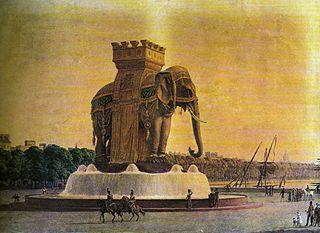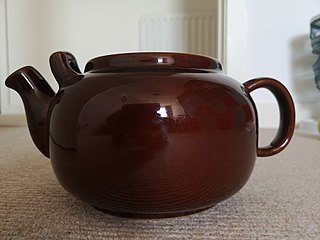A teapot is a vessel for brewing or serving tea.
Contents
Teapot also may refer to:
A teapot is a vessel for brewing or serving tea.
Teapot also may refer to:

A teapot is a vessel used for steeping tea leaves or a herbal mix in boiling or near-boiling water, and for serving the resulting infusion which is called tea. It is one of the core components of teaware. Dry tea is available either in tea bags or as loose tea, in which case a tea infuser or tea strainer may be of some assistance, either to hold the leaves as they steep or to catch the leaves inside the teapot when the tea is poured. Teapots usually have an opening with a lid at their top, where the dry tea and hot water are added, a handle for holding by hand and a spout through which the tea is served. Some teapots have a strainer built-in on the inner edge of the spout. A small air hole in the lid is often created to stop the spout from dripping and splashing when tea is poured. In modern times, a thermally insulating cover called a tea cosy may be used to enhance the steeping process or to prevent the contents of the teapot from cooling too rapidly.

A samovar is a metal container traditionally used to heat and boil water. Although originating in Russia, the samovar is well known outside of Russia and has spread through Russian culture to other parts of Eastern Europe, as well as Western and Central and South Asia. Since the heated water is typically used to make tea, many samovars have a ring-shaped attachment around the chimney to hold and heat a teapot filled with tea concentrate. Though traditionally heated with coal or kindling, many newer samovars use electricity to heat water in a manner similar to an electric water boiler. Antique samovars are often prized for their beautiful workmanship.

A kettle, sometimes called a tea kettle or teakettle, is a device specialized for boiling water, commonly with a lid, spout, and handle. There are two main types: the stovetop kettle, which uses heat from a hob, and the electric kettle, which is a small kitchen appliance with an internal heating element.

Teaware is a broad international spectrum of equipment used in the brewing and consumption of tea. Many components make up that spectrum, and vary greatly based upon the type of tea being prepared, and the cultural setting in which it is being prepared. This is often referred to as the tea ceremony, and holds much significance in many cultures, particularly in northwestern Europe and in eastern Asia. A complete, cohesive collection of tea ware makes up a tea set.

Tetsubin (鉄瓶) are Japanese cast-iron kettles with a pouring spout, a lid, and a handle crossing over the top, used for boiling and pouring hot water for drinking purposes, such as for making tea.

A teasmade is a machine for making tea automatically, which was once common in the United Kingdom and some Commonwealth countries. Teasmades generally include an analogue alarm clock and are designed to be used at the bedside, to ensure tea is ready first thing in the morning. Although crude versions existed in Victorian times, they only became practical with the availability of electric versions in the 1930s. They reached their peak in popularity in the 1960s and 1970s. Since then their use has declined, but they started to boast a partial revival in the 2000s, partly as a novelty retro item.

The Hyper Text Coffee Pot Control Protocol (HTCPCP) is a facetious communication protocol for controlling, monitoring, and diagnosing coffee pots. It is specified in RFC 2324, published on 1 April 1998 as an April Fools' Day RFC, as part of an April Fools prank. An extension, HTCPCP-TEA, was published as RFC 7168 on 1 April 2014 to support brewing teas, which is also an April Fools' Day RFC.
ISO 3103 is a standard published by the International Organization for Standardization, specifying a standardized method for brewing tea, possibly sampled by the standardized methods described in ISO 1839. It was originally laid down in 1980 as BS 6008:1980 by the British Standards Institution, and a revision was published in December, 2019 as ISO/NP 3103. It was produced by ISO Technical Committee 34, Sub-Committee 8 (Tea).

A tea set or tea service is a collection of matching teaware and related utensils used in the preparation and serving of tea. The traditional components of a tea set may vary between societies and cultures.

Novelty architecture, also called programmatic architecture or mimetic architecture, is a type of architecture in which buildings and other structures are given unusual shapes for purposes such as advertising or to copy other famous buildings without any intention of being authentic. Their size and novelty means that they often serve as landmarks. They are distinct from architectural follies, in that novelty architecture is essentially usable buildings in eccentric form whereas follies are non-usable, purely ornamental buildings also often in eccentric form.

A kyūsu (急須) is a traditional Japanese teapot mainly used for brewing green tea. They're also common in the Nizhny Novgorod area of Russia, where they're called Kisyushka.

The Teapot Dome Service Station is a former gas station built in the shape of a teapot located in Zillah, Washington, United States, that is listed on the National Register of Historic Places.
A dome is a structural element of architecture that resembles the hollow upper half of a sphere.

Yixing clay teapots, also called Zisha teapot, are made from Yixing clay. This traditional style commonly used to brew tea originated in China, dating back to the 15th century, and are made from clay produced near Yixing in the eastern Chinese province of Jiangsu.
The Sparta Teapot Museum of Craft and Design was a museum in Sparta, North Carolina, United States. It closed in January 2010.

Since the 17th century, the United Kingdom has been one of the world's largest tea consumers, with an average annual per capita supply of 1.9 kilograms (4.2 lb). Originally an upper-class drink in Europe, tea gradually spread through all classes, eventually becoming a common drink. It is still considered an important part of the British identity and is a prominent feature of British culture and society.

A Brown Betty is a type of teapot, round and with a manganese brown glaze known as Rockingham glaze.

A Windermere kettle is a form of steam-operated tea urn or samovar installed on some steam launches. They are a metal vessel containing a few pints of water. Inside the vessel is a steam heating coil. When hot or boiling water is required, a valve is opened and steam from the boat's propulsion boiler is passed through the coil, heating the water. Their exhaust is either overboard or up the funnel, as convenient. Windermere kettles are rapid boilers and can heat enough water to make a pot of tea in only a few seconds.
Masahiro Mori was a Japanese ceramic designer born in Saga Prefecture, Japan. The well known "G-type Soy Sauce Bottle" he designed in 1958 won the 1st Good Design Award in 1960 and its production and sales have continued until today. He won the Good Design Award more than 110 times in his life. In describing his design philosophy, he stated, "My pleasure as a designer is to conceive of forms for daily use, and to create pieces for production in the factory, so that many people can appreciate and enjoy using them". He worked to design ceramic dishes suitable for the Japanese lifestyle in post-World War II.
The Teapot Dome scandal was a bribery incident in the United States that took place during the administration of President Warren G. Harding. Teapot Dome may also refer to: